EL1 - Lecture 1 Introduction to phonetics and phonology
1/49
Earn XP
Description and Tags
By Vzu Nguyen
Name | Mastery | Learn | Test | Matching | Spaced |
|---|
No study sessions yet.
50 Terms
the speech organs involved in producing sounds | bộ máy phát âm | The tongue, lips, and velum are all examples of _______.
articulators [n.] /ɑːrˈtɪkjəˌleɪtərz/
the movement of speech organs to produce sounds | cách phát âm | Clear _______ is important for effective communication.
articulation [n.] /ɑːˌtɪkjʊˈleɪʃən/
a sound produced with both lips | âm hai môi | The sounds /p/ and /b/ are _______ consonants.
bilabial [adj.] /ˌbaɪˈleɪbiəl/
a sound made with the tongue between or against the teeth | âm răng | The English /θ/ in "think" is an _______ sound.
inter-dental/dental [adj.] /ˌɪntəˈdɛntl/
a sound produced with the tongue against the alveolar ridge | âm lợi | The sounds /t/, /d/, and /s/ are _______ consonants.
alveolar [adj.] /ˌælviˈoʊlər/
a sound made between the alveolar ridge and the hard palate | âm lợi-ngạc cứng | The sounds /ʃ/ and /ʒ/ are _______ consonants.
alveolo-palatal/palato-alveolar [adj.] /ˌælviəloʊ pəˈleɪtl/
a sound produced with the tongue against the hard palate | âm ngạc cứng | The /j/ sound in "yes" is a _______ consonant.
palatal [adj.] /ˈpælətl/
a sound produced with the back of the tongue against the soft palate | âm ngạc mềm | The sounds /k/ and /g/ are _______ consonants.
velar [adj.] /ˈviːlər/
a sound made using the glottis | âm thanh hầu | The sound /h/, known as the _______ stop, occurs in English.
glottal [adj.] /ˈɡlɒtl/
a consonant sound produced by completely blocking airflow | âm tắc | The sounds /p/, /t/, and /k/ are examples of _______ consonants.
stop (oral stop/plosive) [n.] /stɒp/
a consonant produced with airflow through the nose | âm mũi | The sounds /m/, /n/, and /ŋ/ are _______ consonants.
nasal (nasal stop) [n.] /ˈneɪzl/
a consonant produced by forcing air through a narrow passage | âm xát | The sounds /f/, /s/, and /ʃ/ are _______ consonants.
fricative (spirant) [n.] /ˈfrɪkətɪv/
a sound that begins as a stop and releases as a fricative | âm tắc xát | The sounds /tʃ/ and /dʒ/ are examples of _______ consonants.
affricate [n.] /ˈæfrɪkət/
a consonant produced with minimal constriction | âm gần | The sounds /r/ and /w/ are _______ consonants.
approximant (frictionless continuant) [n.] /əˈprɒksɪmənt/
a consonant produced by allowing air to flow along the sides of the tongue | âm bên | The English /l/ is a _______ consonant.
lateral [adj.] /ˈlætərəl/
a consonant produced with the tongue curled back | âm quặt lưỡi | In English, /r/ is a _________
retroflex [adj.] /ˈrɛtrəʊflɛks/
a sound that behaves like a vowel but functions as a consonant | âm lướt (bán nguyên âm) | The sounds /w/ and /j/ are _______ in English.
glide (semi-vowel) [n.] /ɡlaɪd/
a vowel with a single, unchanging sound | nguyên âm đơn | The vowel /iː/ in "see" is a _______.
monophthong [n.] /ˈmɒnəfθɒŋ/
a vowel sound that glides from one position to another | nguyên âm đôi | The vowel /aɪ/ in "time" is a _______.
diphthong [n.] /ˈdɪfθɒŋ/
the bony ridge behind the upper front teeth where alveolar sounds are produced | xương ổ răng | The English /t/ and /d/ are pronounced with the tongue touching the _______.
alveolar ridge [n.] /ælˈviːələr rɪdʒ/
the hard part of the roof of the mouth | ngạc cứng | The /j/ sound in "yes" is produced near the _______.
(hard) palate [n.] /hɑːrd ˈpælɪt/
the soft part of the roof of the mouth, also called the soft palate | ngạc mềm | The sounds /k/ and /g/ are articulated at the _______.
velum [n.] /ˈviːləm/
the throat area behind the oral and nasal cavities | hầu | The _______ is involved in swallowing and speech production.
pharynx [n.] /ˈfærɪŋks/
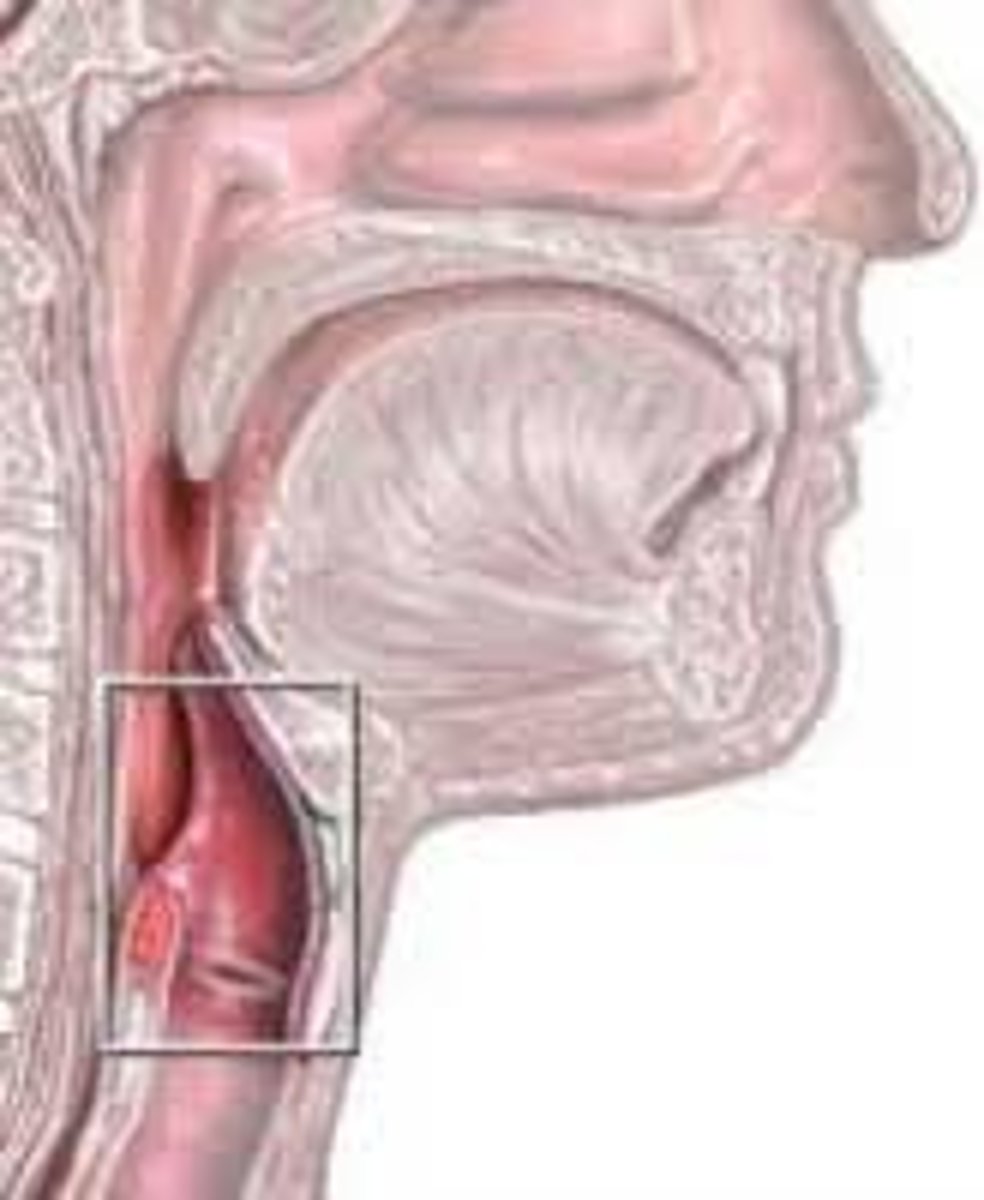
the voice box, containing the vocal cords | thanh quản | The _______ plays a key role in phonation by controlling the vocal cords.
larynx [n.] /ˈlærɪŋks/
two muscle folds in the larynx that vibrate to produce sound | dây thanh âm | The _______ vibrate to create voiced sounds like /b/ and /d/.
vocal cords [n.] /ˈvoʊkəl kɔːrdz/

the space between the vocal cords | thanh môn | The _______ opens and closes during speech production.
glottis [n.] /ˈɡlɒtɪs/
the mouth area where speech sounds are shaped | khoang miệng | Vowel sounds are formed by shaping the air in the _______.
oral cavity [n.] /ˈɔːrəl ˈkævɪti/
the space inside the nose involved in nasal sound production | khoang mũi | The sounds /m/, /n/, and /ŋ/ resonate in the _______.
nasal cavity [n.] /ˈneɪzəl ˈkævɪti/
the tip of the tongue | đầu lưỡi | The English /s/ and /z/ sounds are often produced with the _______ of the tongue.
apex [n.] /ˈeɪpɛks/
the blade of the tongue, just behind the tip | mặt lưỡi | Some sounds, like /ʃ/ in "shoe," are articulated using the _______ of the tongue.
lamina [n.] /ˈlæmɪnə/
the back part of the tongue used in velar sounds | lưng lưỡi | The sounds /k/ and /g/ involve the _______ of the tongue pressing against the velum.
dorsum [n.] /ˈdɔːrsəm/

the windpipe that carries air from the larynx to the lungs | khí quản | Air passes through the _______ before reaching the vocal cords for speech production.
trachea [n.] /ˈtreɪkiə/
• The ___________ (the voice box / the Adam's apple)
a tube-shaped organ in the neck that contains the vocal cords. It's located between the pharynx and the trachea.
• The ________ ________
Two small bands of elastic tissue, which can be thought of as two flat strips or rubber, lying opposite each other across the air passage in the larynx.
The inner edges of the vocal cords can be moved towards each other so that they completely cover the top of the wind pipe (the _________), or can be drawn apart so that there is a gap between them.
larynx, vocal cords, trachea
• The ________
The space behind the tongue, immediately above the larynx, reaching up towards the nasal cavity.
• The _________
Forms the roof of the mouth.
Separates the mouth/oral cavity from the nose/nasal cavity.
The front part is hard, while the back part is soft.
The soft palate (__________) can be raised so that it makes a firm contact with the back wall of the pharynx.
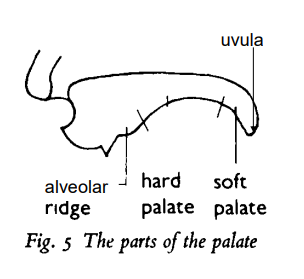
pharynx, palate, velum
• The teeth
• The lower front teeth are not very important in speech.
• The ________ ________ teeth are more ______________ used in English.
• The ___________
• The most important of the speech organs because it has the greatest variety of movement.
• Divided into five parts: ___, ______, ______, _______ (and ______).
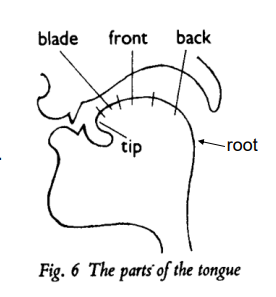
upper front, frequently, tongue, tip, blade, front, back, root
• The ______:
• Consist of the upper lip and lower lip.
• Can take various different positions:
• brought firmly together so that they completely block the mouth.
• the lower lip can be drawn inwards to touch the upper front teeth.
• kept apart either flat or with different amount of rounding.
• pushed forward to a greater or lesser extent.
lips
How are speech sounds produced?
• When we are making sounds, the air from the ____________ comes up through the windpipe/__________ and arrives at the ___________.
• Then it goes through the __________ ___________ into the __________ and up to the uvula.
• At this point, the air may go in either way:
• It may go into the ______ ________ & get out through the mouth.
• Or it may go into the _________ __________ & get out though the nose.
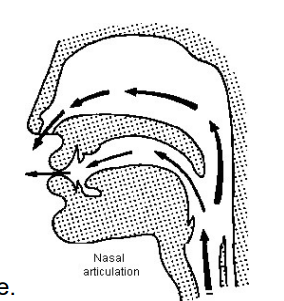
lungs, trachea, larynx, vocal cords, pharynx, oral cavity, nasal cavity
Oral vs. Nasal sounds
1. How are oral sounds produced?
• Oral sounds are the sounds in the production of which the soft palate (_________) is __________, blocking off the _______ _______ so that the airstream can only get out through the mouth.
• E.g. /b, ɡ, ʊ, ʃ, æ/
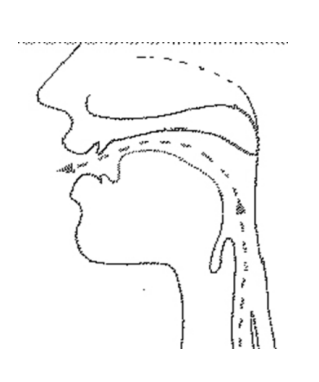
velum, raised, nasal cavity
2. How are nasal sounds produced?
• Nasal sounds are the sounds in the production of which the soft palate (___________) is ___________, blocking off the ________ ___________ so that the airstream can only get out through the nose.
• There are only three nasal sounds in English: /m, n, ŋ/
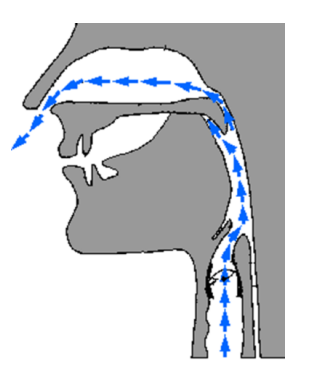
velum, lowered, oral cavity,
Consonants vs. Vowels
3. How are consonant sounds produced?
When we are making sounds, if two articulators come together, ______________ the air-stream and the air-stream ___________ get out freely, we have consonant sounds. In other words, there is some ____________ or ___________ of the ____-________.
E.g. /k/, /f/, /b/, /m/
4. How are vowel sounds produced?
When we are making sounds, if there is ____ ______________ to the flow of air as it passes from the ____________ to the lips, and the air can get out __________ , then we have vowel sounds. In other words, they are produced with ________ _________________.
E.g. /ɒ/, /ɜː/, /æ/, /ɪ/
obstructing, cannot, stricture, closure, air-stream, no obstruction, larynx, freely, open articulation
Consonants vs. Vowels
• Problem in English: Một số phụ âm thực sự không cản trở luồng không khí nhiều hơn nguyên âm (Translate this into English).
Eg. the beginning sound of 'hay' and 'way'
=> The classification of sounds can also be based on their distribution in the syllable. (VD: cách phát âm của /w/ và /j/ giống nguyên âm, because there is no obstruction to the air stream, nhưng thường không được làm trung tâm của âm tiết mà lại ở đầu hoặc cuối nên /w/ và /j/ là phụ âm. Vì tính chất như vậy nên /w/ và /j/ được gọi là bán nguyên âm - semivowel/glide)
some consonants do not really obstruct the air flow more than vowels do
• Problem in English:
some consonants do not really obstruct the flow of air more than vowels do.
Eg. the beginning sound of '_____' and '______'
=> The classification of sounds can also be based on their distribution in the syllable.
hay, way
Consonants vs. Vowels
• Problem in English: some consonants do not really obstruct the flow of air more than vowels do.
Eg. the beginning sound of 'hay' and 'way'
=> The classification of sounds can also be based on their ________________ ___ ______ ________________ .
distribution in the syllable
Voiced sounds vs. Voiceless sounds
5. How are voiced sounds produced?
When we are producing sounds, the air-stream goes through the ________ _________. If the vocal cords ________ ____________, obstructing the air-stream, the air-stream __________ get out through them freely and it makes them ________, then we have voiced sounds.
E.g. /d/, /v/, /m/
6. How are voiceless sounds produced?
When we are making sounds, the air-stream goes through the vocal cords. If the vocal cords come apart, they are open. The air-stream can go out through them freely and it does not make them vibrate, then we have voiceless sounds.
E.g./s/, /t/, /ʃ/
vocal cords, come together, cannot, vibrate
Voiced sounds vs. Voiceless sounds
5. How are voiced sounds produced?
When we are producing sounds, the air-stream goes through the vocal cords. If the vocal cords come together, obstructing the air-stream, the air-stream cannot get out through them freely and it makes them vibrate, then we have voiced sounds.
E.g. /d/, /v/, /m/
6. How are voiceless sounds produced?
When we are making sounds, the air-stream goes through the vocal cords. If the vocal cords _________ _________, they are _______. The air-stream can go out through them ________ and it does ____ make them __________, then we have voiceless sounds.
E.g./s/, /t/, /ʃ/
come apart, open, freely, not, vibrate
Which of the following are "passive" articulators: teeth, the lower lip, the apex of the tongue, velum, and alveolar ridge?
teeth, velum, alveolar ridge
Which of the following are "active" articulators: teeth, the lower lip, the tongue, velum, and the alveolar ridge?
lower lip, tongue
What are the three approximants? Give their names and the consonant sounds accordingly
lateral /l/, retroflex /r/, glide /w/ /j/
A consonant is defined as a speech sound which is articulated with some kind of stricture, or closure, of the air stream.
Consonants are classified according to four features:
1. the state of the glottis: in vibration (voiced) or open (voiceless);
2. the state of the velum: lowered (nasal) or raised (oral);
3. the place of articulation: the location where the stricture or place of maximum interference occurs and what articulators are involved; and
4. the manner of articulation: the amount of stricture, whether it is complete, partial (called “close approximation”), or relatively open (“open approximation”).
The term “approximation” refers to the two articulators approaching (or approximating) one another.
In describing the place of articulation for consonants, it is traditional to list the active and then the passive articulator. Consonants involve a rather large number of discrete places of articulation (see Figure 2.3):
1.________: the lips are brought together (the lower lip is active); the tongue is not involved but remains in the “rest position” (its position when you say ah for the doctor) – e.g. the sound of “b” in English;
2.____________: the lower lip is brought up against the upper front teeth; again the tongue is in rest position – e.g. the sound of “f ” in English;
3.__________: the tip of the tongue (or apex) protrudes between the teeth or touches the back of the upper teeth – e.g. the sound of “t” in Spanish or “th” in English;
4.________: the tip of the tongue makes contact with or is in close approximation to the alveolar ridge – e.g. the sound of “d” in English;
5._______________: the front, or blade, of the tongue is raised to an area between the alveolar ridge and the palate – e.g. the sound of “sh” in English;
6.________: the front of the tongue is brought up against the palate – e.g. the sound of “y” in English;
7.______: the back, or dorsum, of the tongue is brought into contact with the velum – e.g. the sound of “g” in English;
8. uvular: the back of the tongue touches the uvula;
9. pharyngeal: the root of the tongue (specifically, the epiglottis) is moved backwards against the wall of the pharynx; and
10.________: the vocal cords, functioning as articulators, make a brief closure.
bilabial, labiodental, dental, alveolar, alveolopalatal, palatal, velar, glottal
While the uvular and pharyngeal places are not used for the articulation of English consonants, they are used in other languages: e.g. the uvular for German “r” and a French fricative and the pharyngeal for a fricative in Arabic.
Each of the various places of articulation just examined may combine with a number of different manners of articulation to produce consonant sounds:
1.____: (“____ _____”) involving complete closure of two articulators with the velum raised (velic closure) – e.g. the sound of “p” in English;
2._____: (“____ _____”) involving complete closure of two articulators with the velum lowered (“velic opening”) – e.g. the sound of “n” in English; for every stop position in English, there is a nasal articulated in the same position (homorganic);
3._______: (or “_______”) involving close approximation of two articulators; the air stream is partially obstructed so that a turbulent airflow is produced, resulting in a hissing or rubbing sound – e.g. the sound of “s” in English;
4.__________: consisting of a stop released into a homorganic fricative – e.g. the sound of “ch” in English; this sound is analyzed either as a complex or a simple sound;
5. trill: (or “roll”) involving complete closure alternating intermittently with open approximation, that is, a rapid vibration of the active articulator against the passive articulator (this sound in not common in English except for the Scottish “r” made with an apical trill);
6. flap: (or “tap”) involving momentary complete closure in which the active articulator strikes the passive articulator only once; it is one strike of a trill and similar to a stop except that the tongue is more tense and controlled than in a stop; and
7.___________: one articulator approaches another but generally not to the extent that a turbulent air stream is produced; there is usually open approximation in the three different types of approximants:
a. _______: involving complete closure of the central portion of the vocal tract, with the lateral passage of air; the air may pass around the sides with no stricture (open approximation) – e.g. the sound of “l” in English – or, in languages other than English, with some stricture (close approximation);
b.________: involving the underside of the tongue curling back behind the alveolar
ridge towards the palate – e.g. the sound of “r” in English; laterals and retroflexes are called “liquids”;
c. ______ (or _________): involving a glide to or from a vowel; this sound is articulated like a vowel (with no stricture) but functions as a consonant to begin or end syllables – e.g. the sound of “w” in English.
stop, oral stop, nasal, nasal stop, fricative, spirant, affricate, approximant, lateral, retroflex, glide, semivowel